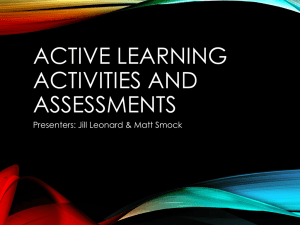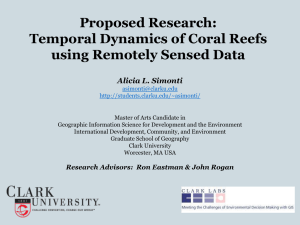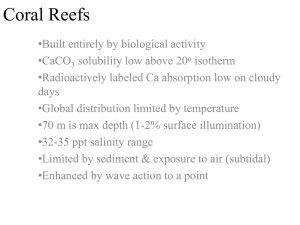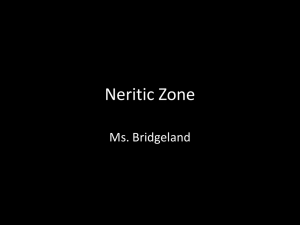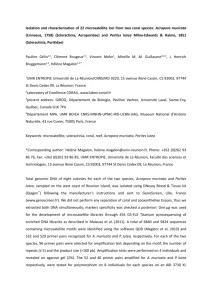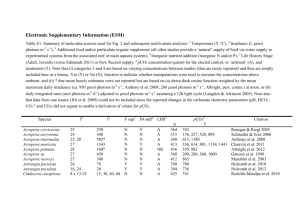Reversing the Tide of Coral Reef Degradation
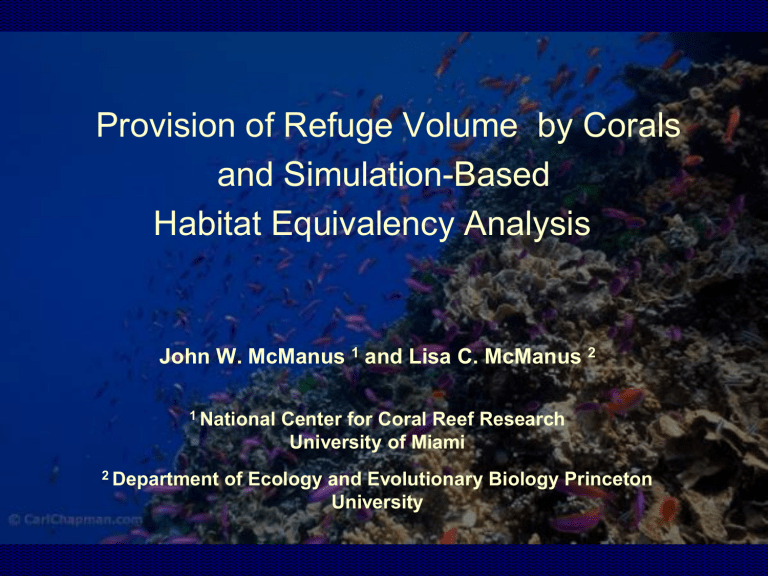
Provision of Refuge Volume by Corals and Simulation-Based
Habitat Equivalency Analysis
John W. McManus 1 and Lisa C. McManus 2
1 National Center for Coral Reef Research
University of Miami
2 Department of Ecology and Evolutionary Biology Princeton
University
Refuge Volume
xda-wallpapers.com
Steve Turek/Coral Reef Alliance
Coral Reef Alliance
Requirements for Refuge
Volume Estimations
Estimation procedure should scale properly.
At a minimum, one should find a factor which is multiplied by a dimension cubed.
800
600
400 vol = c f d 3
200 surf = c f d 2
0
0 5
Dimension (e.g. radius)
10
Basic Shape Formulas
Surface Area
Square
Cube
Circle
Semicircle
Cylinder
(no ends)
Sphere
Spherical
Wedge
Not used
Volume
--
--
--
Hemisphere
(no bottom)
Growth Form
Branching
Columnar Small <10 cm
Columnar Large 10+ cm
Disc-Solitary
Encrusting
Foliose
Massive
Plate
Table
Mixed Plate-Column
(such as often in
Porites rus)
Surface Area
0.47𝜇 2
0.31𝜇 2
7.85𝜇 2
1.57𝜇 2
0.78𝜇 2
0.78𝜇 3
1.57𝜇 2
0.69𝜇
2
1.57𝜇 2
8.29𝜇
2
Refuge Volume
0.13𝜇 3
0.0026𝜇 3
0.16𝜇 3
NA
NA
0.39𝜇 3
0.011𝜇 3
0.052𝜇
3
0.15𝜇 3
0.21𝜇
3
Application of Refuge
Volume Estimation
Apra Harbor Guam will have dredging impacting up to 1 sq. km of reef area – the largest US reef mitigation case so far.
The map shows refuge volume available due to corals (larger circles mean more volume).
Evaluation of substrate and other HAB contribution to local refuge volume is underway.
This information is being used to minimize impacts and establish mitigation goals
.
Bottom Cover
50
40
30
20
10
0
98 33 76 95 50 32 41 80 18 3 45 101 97 39 10 59 20 100 94 93 90 14 4 29 96 91 71 30 86 84 99 19 70
Site No.
Surface Area
600
500
400
300
200
100
0
3,5
3
2,5
2
1,5
1
0,5
0
98 33 76 95 50 32 41 80 18 3 45 101 97 39 10 59 20 100 94 93 90 14 4 29 96 91 71 30 86 84 99 19 70
Site No.
Refuge Volume
98 33 76 95 50 32 41 80 18 3 45 101 97 39 10 59 20 100 94 93 90 14 4 29 96 91 71 30 86 84 99 19 70
Site No.
DigiReef for Habitat
Equivalency Analysis
(HEA)
Problems with Assuming
Linear Recovery
120
100
80
60 b
40
20 a
0
1 2 3 4 5 6 7 8
Years
9 10 11 12 13 14 15
Simulation Parameters
Coral growth rate
Used literature values
Coral rate of instantaneous mortality
Applied catch curves to size data by species and form
Where necessary, combined similar species
Coral rate of annual recruitment
Used simple virtual population analysis
Colony maximal dimension
Based on maximal sizes in the site
Estimating Rates of Mortality 𝑛 𝑡
= 𝑛
0 𝑒 −𝑧𝑡 ln(𝑛 𝑡
) = −zt + ln(𝑛
0
) 𝑦 = 𝑚𝑥 + 𝑏
Estimating Rates of Mortality
Estimating Annual Recruitment
Year
2001
2002
2003
2004
1
100
100
100
100
Age in Years or Radius in Centimeters
2 3 4 5 6 7 8 9 10
61
61
61
61
37
37
37
37
22
22
22
22
14 8 5 3 2 1
14 8 5 3 2 1
14 8 5 3 2 1
14 8 5 3 2 1
2005
2006
2007
2008
2009
100
100
100
100
100
61
61
61
61
61
37
37
37
37
37
22
22
22
22
22
14
14
14
14
14
8
8
8
8
8
5
5
5
5
5
3
3
3
3
3
2
2
2
2
2
1
1
1
1
1
2010 100 61 37 22 14 8 5 3 2 1
Empirical: 1000 610 370 220 140 80 50 30 20 10
DigiReef Inputs: Site 93
Pavona decussata
Pocillopora damicornis
Porites cylindrica
Porites lutea
Porites rus
Recruitment (settled corals per year)
Battle skill (relative hierarchy)
Growth rate (cm / y)
3
2
2
1
1
2
3
4
4
3
3
2
Instantaneous mortality
Volume factor
0.127
0.393
Maximum radius
20
0.12
0.126
20
0.025
0.126
0.122
0.011
10
20
1 3 2 0.027
0.21
30
Color
Blue
Red
Yellow
Violet
Orange
Species
Pavona decussata
Pocillopora damicornis
Porites cylindrica
Porites lutea
Porites rus
Simulated Regrowth: Site 93
80%
60%
Total coral cover
40%
20%
0%
0
1000
800
600
400
200
0
0
20
20
2000
1500
1000
500
Spectra of refuge volumes
40 60 80
Individuals per species
40 60
100 120 0
0
200
150
100
50
20 40 60 80 100 120
Spectra of sizes of massive corals
( Porites lutea )
80 100 120
0
0
Years of simulated regrowth
20 40 60 80 100 120
Conclusions I
Refuge volume is an important metric for quantifying ecosystem function.
It can be associated with corals, other habitat structuring benthos, and the substrate itself.
It is not necessarily well correlated with coral cover or surface area indices.
Estimation procedures still require improvements from field and laboratory measurements.
Conclusions II
DigiReef simulation can improve the basis for the determination of compensatory requirements in mitigation cases.
Coral mortality and recruitment can be roughly approximated via fishery analytical methods.
For one particular site, the original coral cover and size spectra of massive corals was optimally achieved, and community structure was nearly optimally achieved, within 40 years.
The spectrum of available refuge volumes was replicated within 8 years, because most was due to small branching and foliose coral colonies. These results will vary in different coral communities.
Acknowledgements
Our thanks to:
Deborah Shafer and others at the US Army Corps of Engineers, Engineer Research and
Development Center.
US Navy, NOAA, US EPA, Gov. Guam, others, especially Steve Kolinski
HDR-EOC and CSA International Consultancy
Firms
Dr. Yimnang Golbuu and others for field work
Thank you.




